Subgrid Model of Water Storage in Paddy Fields for a Grid-Based Distributed Rainfall–Runoff Model and Assessment of Paddy Field Dam Effects on Flood Control
Abstract
1. Introduction
2. Study Site
3. Methods
3.1. Modeling Methods
3.1.1. Subgrid Model for Water Storage in Paddy Fields
3.1.2. Fundamental Equations in this Model
3.1.3. Evaluation of Drainage from Paddy Fields
3.1.4. Paddy Field Dam Model with Vertical Pipes
3.2. Computational Procedures for a Preliminary Study of Paddy Field Division for Each Grid in This Model
3.3. Main Calculation Procedures for Assessing the Effects of Paddy Field Dams on Flood Control in the Kashima River Basin Using the Present Model
4. Results
4.1. Preliminary Calculation for Determining the Effects of Paddy Field Division for Each Grid
4.2. Results Obtained for the Main Calculations
4.2.1. River Discharge
4.2.2. Water Depth in Paddy Fields
4.2.3. Water Balances at the Basin Scale
5. Discussion
6. Conclusions
- (1)
- The fundamental concepts of the subgrid model to overcome the issues of the existing runoff models are to (a) maintain the general grid-based distributed rainfall–runoff model framework, (b) reflect the detailed land use in the computational grid, and (c) appropriately account for the effect of the paddy field storage. Fundamental equations are separately derived for paddy and non-paddy fields; however, the basic form of the RRI model remains unchanged. The subgrid model can be used to evaluate the storage effect of paddy field dams without losing the computational framework of the runoff model.
- (2)
- To investigate the effect of current paddy field storage and the introduction of a paddy field dam on the reduction in peak flood discharge, rainfall–runoff analysis was conducted in the Kashima River basin using the model developed in this study. The model parameters were calibrated to fit the peak river discharge through the runoff simulations for ten flood events in the Kashima River basin. The computational results highlighted that the rainwater storage effect of the current paddy field reduces the peak river discharge significantly, thereby suggesting that the drainage process of the paddy field should be incorporated into a model configuration for runoff analysis, including the paddy field area. Notably, the paddy field storage effect became more pronounced when the height of the drainage pipe in the paddy field dam increased.
- (3)
- To understand the effect of paddy field storage on the water balance characteristics of the entire basin, temporal changes in water volume throughout the basin were examined. Based on the water balance characteristics, the improvement in the paddy field storage effect decreases the river channel storage and, consequently, the river discharge.
Supplementary Materials
Author Contributions
Funding
Data Availability Statement
Acknowledgments
Conflicts of Interest
Abbreviations
| a | Cross-sectional area of the drainage pipe; |
| A | Catchment area; |
| Ap | Area of the paddy field in the grid; |
| Average area of one paddy field in the study area (=1320 m2); | |
| C | Coefficient of contraction; |
| ErrQpeak | RMS value for the error in calculated peak flows for the 10 flood events; |
| f | Vertical infiltration intensity (unit: m/s); |
| f1, f2, f3, f4 | Vertical infiltration intensity for paddy fields, farmlands, forests, and urban areas, respectively; |
| h | Depth; |
| H | Water level; |
| hd | Outlet height of the drainage pipe; |
| hp | Water depth in the paddy field; |
| hs | Water depth in the non-paddy field area; |
| Hp & Qp | Water level and discharge for a circular free-draining pipe; |
| h∞ | Steady state depth in the preliminary calculation; |
| kv & ka | Vertical and lateral infiltration coefficients, respectively; |
| n | Roughness coefficient; |
| Averaged using ni and αi for each land use type; | |
| qx and qy | Unit width discharges in the x and y directions, respectively; |
| & | Inflows and outflows from the adjacent paddy fields, respectively; |
| qout | Amount of drainage from the paddy field; |
| Qpeak | Peak discharge in main calculations; |
| r | Rainfall intensity (unit: m/s); |
| RQ | Reduction rate for the peak discharge in each case with respect to the current condition (Case 1); |
| Sd | Soil depth; |
| Sf | Suction; |
| sgn | Sign function; |
| t | Time; |
| VR, VS, VP, Vsub-f and Vsub-o | Water volume in river storage, surface flow storage, paddy field storage, the sub-surface volume in forests, and cumulative volume of vertical infiltration in paddy fields and farmlands; |
| W | Channel width; |
| x, y | Horizontal directions; |
| α1, α2, α3, α4 | Area fraction for paddy fields, farmlands, forests, and urban areas, respectively, in each grid; |
| γa & γm | Porosities of the saturated and unsaturated layer, respectively; |
| Cumulative discharge at the downstream end of entire basin. |
References
- Rahmayanti, K.P.; Azzahra, S.; Arnanda, N.A. Actor-Network and Non-Government failure in Jakarta flood disaster in January 2020. IOP Conf. Ser. Earth Environ. Sci. 2021, 716, 012053. [Google Scholar] [CrossRef]
- Zhou, Z.Q.; Xie, S.P.; Zhang, R. Historic Yangtze flooding of 2020 tied to extreme Indian Ocean conditions. Proc. Natl. Acad. Sci. USA 2021, 118, e2022255118. [Google Scholar] [CrossRef] [PubMed]
- Koks, E.; Van Ginkel, K.; Van Marle, M.; Lemnitzer, A. Brief Communication: Critical Infrastructure impacts of the 2021 mid-July western European flood event. Nat. Hazards Earth Syst. Sci. 2021, 22, 3831–3838. [Google Scholar] [CrossRef]
- Cabinet Office (Government of Japan). On Disaster Damage by the Heavy Rainfall in July 2018. 2018. Available online: http://www.bousai.go.jp/updates/h30typhoon7/pdf/310109_1700_h30typhoon7_01.pdf (accessed on 23 June 2022). (In Japanese).
- Cabinet Office (Government of Japan). On Disaster Damage by the Typhoon No. 19 (Hagibis) in 2019; Cabinet Office (Government of Japan): Tokyo, Japan, 2019. (In Japanese) [Google Scholar]
- Cabinet Office (Government of Japan). On Disaster Damage by the Heavy Rainfall in July 2020. 2020. Available online: http://www.bousai.go.jp/updates/r2_07ooame/pdf/r20703_ooame_40.pdf (accessed on 23 June 2022). (In Japanese).
- Kawase, H.; Imada, Y.; Tsuguti, H.; Nakaegawa, T.; Seino, N.; Murata, A.; Takayabu, I. The heavy rain event of July 2018 in Japan enhanced by historical warming. Bull. Am. Meteorol. Soc. 2020, 101, S109–S114. [Google Scholar] [CrossRef]
- Kawase, H.; Yamaguchi, M.; Imada, Y.; Hayashi, S.; Murata, A.; Nakaegawa, T.; Miyasaka, T.; Takayabu, I. Enhancement of extremely heavy precipitation induced by Typhoon Hagibis (2019) due to historical warming. Sci. Online Lett. Atmos. 2021, 17A, 7–13. [Google Scholar] [CrossRef]
- IPCC AR6. Climate Change 2021: AR6 Synthesis Report. 2021. Available online: https://www.ipcc.ch/report/sixth-assessment-report-cycle/ (accessed on 23 June 2022).
- Ministry of Land Infrastructure, Transport and Tourism (MLIT). River Basin Disaster Resilience and Sustainability by All. 2020. Available online: https://www.mlit.go.jp/river/kokusai/pdf/pdf21.pdf (accessed on 23 June 2022).
- Abler, D. Multifunctionality, agricultural policy, and environmental policy. Agric. Econ. Res. Rev. 2004, 33, 8–17. [Google Scholar] [CrossRef]
- Groenfeldt, D. Multifunctionality of agricultural water: Looking beyond food production and ecosystem services. Irrig. Drain. 2006, 55, 73–83. [Google Scholar] [CrossRef]
- Wu, R.S.; Sue, W.R.; Chien, C.B.; Chen, C.H.; Chang, J.S.; Lin, K.M. A simulation model for investigating the effects of rice paddy fields on the runoff system. Math. Comput. Model. 2001, 33, 649–658. [Google Scholar] [CrossRef]
- Huang, C.C.; Tsai, M.H.; Lin, W.T.; Ho, Y.F.; Tan, C.H. Multifunctionality of Paddy fields in Taiwan. Paddy Water Environ. 2006, 4, 199–204. [Google Scholar] [CrossRef]
- Masumoto, T.; Yoshida, T.; Kubota, T. An index for evaluating the flood prevention function of paddies. Paddy Water Environ. 2006, 4, 205–210. [Google Scholar] [CrossRef]
- Matsuno, Y. Prospects for multifunctionality of paddy rice cultivation in Japan and other countries in monsoon Asia. Paddy Water Environ. 2006, 4, 189–197. [Google Scholar] [CrossRef]
- Kim, T.C.; Gim, U.S.; Kim, J.S.; Kim, D.S. The multi-functionality of paddy farming in Korea. Paddy Water Environ. 2006, 4, 169–179. [Google Scholar] [CrossRef]
- Kim, J.O.; Lee, S.H.; Jang, K.S. Efforts to improve biodiversity in the paddy field ecosystem of South Korea. Reintroduction 2011, 1, 25–30. Available online: http://www.stork.u-hyogo.ac.jp/downloads/journal/01_05.pdf (accessed on 23 June 2022).
- Sujono, J. Flood reduction function of paddy rice fields under different water saving irrigation techniques. J. Water Resour. 2010, 2, 555–559. [Google Scholar] [CrossRef]
- Hao, L.; Sun, G.; Liu, Y.; Wan, J.; Qin, M.; Qian, H.; Liu, C.; Zheng, J.; John, R.; Fan, P.; et al. Urbanization dramatically altered the water balances of a paddy. Hydrol. Earth Syst. Sci. 2015, 19, 3319–3331. [Google Scholar] [CrossRef]
- Yoshikawa, N.; Nagao, N.; Misawa, S. Evaluation of the flood mitigation effect of a Paddy Field Dam project. Agric. Water Manag. 2010, 97, 259–270. [Google Scholar] [CrossRef]
- Miyazu, S.; Matsushita, T.; Iwamura, Y.; Yoshikawa, N. Study on limit of flood mitigation effect of paddy field dam. Eng. Ser. B1 Hydraul. Eng. 2020, 76, I_805–I_810. (In Japanese) [Google Scholar] [CrossRef]
- Kobayashi, K.; Kono, Y.; Kimura, T.; Tanakamaru, H. Estimation of paddy field dam effect on flood mitigation focusing on Suse region of Hyogo, Japan. Hydrol. Res. Lett. 2021, 15, 64–70. [Google Scholar] [CrossRef]
- Chen, R.; Cheng, Y.; Huang, P. A suitable design of outlet type for paddies in Taiwan by evaluating the flood detention effect and applicability. Irrig. Drain. Syst. 2019, 68, 937–949. [Google Scholar] [CrossRef]
- Chai, Y.; Touge, Y.; Shi, K.; Kazama, S. Evaluating potential flood mitigation effect of paddy field dam for Typhoon No. 19 in 2019 in the Naruse River basin. Eng. Ser. B1 Hydraul. Eng. 2020, 76, 295–303. [Google Scholar] [CrossRef]
- Abbott, M.B.; Bathurst, J.C.; Cunge, J.A.; O’Connell, P.E.; Rasmussen, J. An introduction to the European Hydrological System-Systeme Hydrologique European. ‘SHE’, 1: History and philosophy of a physically based distributed modelling system. J. Hydrol. 1986, 87, 45–59. [Google Scholar] [CrossRef]
- Abbott, M.B.; Bathurst, J.C.; Cunge, J.A.; O’Connell, P.E.; Rasmussen, J. An introduction to the European Hydrological System-Systeme Hydrologique European, ‘SHE’, 2: Structure of a physically based distributed modelling system. J. Hydrol. 1986, 87, 61–77. [Google Scholar] [CrossRef]
- Jia, Y.W.; Ni, G.H.; Yoshihisa, K. Development of WEP model and its application in urban area. Hydrol. Process 2001, 15, 2175–2194. [Google Scholar] [CrossRef]
- Noh, S.J.; Tachikawa, Y.; Shiiba, M.; Kim, S. Ensemble Kalman filtering and particle filtering in a lag-time window for short-term streamflow forecasting with a distributed hydrologic model. J. Hydrol. 2013, 18, 1684–1696. [Google Scholar] [CrossRef]
- Sayama, T.; Ozawa, G.; Kawakami, T.; Nabesaka, S.; Fukami, K. Rainfall-runoff-inundation analysis of the 2010 Pakistan flood in the Kabul River basin. Hydrol. Sci. J. 2012, 57, 298–312. [Google Scholar] [CrossRef]
- Wang, S.; Zhang, Z.; Sun, G.; Strauss, P.; Guo, J.; Tang, Y.; Yao, A. Multi-site calibration, validation, and sensitivity analysis of the MIKE SHE Model for a large watershed in northern China. Hydrol. Earth Syst. Sci. 2012, 16, 4621–4632. [Google Scholar] [CrossRef]
- Jia, Y.; Wang, H.; Zhou, Z.; Qiu, Y.; Luo, X.; Wang, J.; Yan, D.; Qin, D. Development of the WEP-L distributed hydrological model and dynamic assessment of water resources in the Yellow River basin. J. Hydrol. 2006, 331, 606–629. [Google Scholar] [CrossRef]
- Leonarduzzi, E.; Maxwell, R.M.; Mirus, B.B.; Molnar, P. Numerical analysis of the effect of subgrid variability in a physically based hydrological model on runoff, soil moisture, and slope stability. Resour. Res. 2021, 57, e2020WR027326. [Google Scholar] [CrossRef]
- Antoine, M.; Javaux, M.; Bielders, C.L. Integrating subgrid connectivity properties of the micro-topography in distributed runoff models, at the interrail scale. J. Hydrol. 2011, 403, 213–223. [Google Scholar] [CrossRef]
- Beldring, S.; Engeland, K.; Roald, L.A.; Sælthun, N.R.; Voksø, A. Estimation of parameters in a distributed precipitation-runoff model for Norway. Hydrol. Earth Syst. Sci. 2003, 7, 304–316. [Google Scholar] [CrossRef]
- Hagemann, S.; Gates, L.D. Improving a subgrid runoff parameterization scheme for climate models by the use of high-resolution data derived from satellite observations. Dynamics 2003, 21, 349–359. [Google Scholar] [CrossRef]
- Liang, X.; Xie, Z. A new surface runoff parameterization with subgrid-scale soil heterogeneity for land surface models. Adv. Water Resour. 2001, 24, 1173–1193. [Google Scholar] [CrossRef]
- Neal, J.; Schumann, G.J.-P.; Bates, P.D. A simple model for simulating river hydraulics and floodplain inundation over large and data sparse areas. Water Resour. Res. 2012, 48, W11506. [Google Scholar] [CrossRef]
- Jung, I.K.; Park, J.Y.; Park, G.; Lee, M.S.; Kim, S.J. A grid-based rainfall-runoff model for flood simulation including paddy fields. Paddy Water Environ. 2011, 9, 275–290. [Google Scholar] [CrossRef]
- Sayama, T.; Tatebe, Y.; Tanaka, S. An emergency response-type rainfall runoff-inundation simulation for 2011 Thailand floods. J. Flood Risk Manag. 2015, 10, 65–78. [Google Scholar] [CrossRef]
- Yamashita, A. Mesh Data Analysis of Watershed Environment Focusing on Land Use and Water Supply-demand. Environ. Sci. 2019, 32, 36–45, (In Japanese with English abstract). [Google Scholar]
- Chiba Prefecture. The 18th Chiba Prefecture Disaster Countermeasures Headquarters Meeting. 2019. Available online: https://www.pref.chiba.lg.jp/bousai/bousai/documents/kaigi18-2.pdf (accessed on 23 June 2022). (In Japanese).
- Rawls, W.J.; Ahuja, L.R.; Brakensiek, D.L.; Shirmohammadi, A. Infiltration and soil water movement. In Handbook of Hydrology; McGraw-Hill: New York, NY, USA, 1992; pp. 5.1–5.52. [Google Scholar]
- Yamazaki, D.; Togashi, S.; Takeshima, A.; Sayama, T. High-resolution flow direction map of Japan. J. Jpn. Soc. Civ. Eng. Ser. B1 Hydraul. Eng. 2020, 8, 234–240. [Google Scholar] [CrossRef]
- Shimada, M.; Isoguchi, O.; Motooka, T.; Shiraishi, T.; Mukaida, A.; Okumura, H.; Otaki, T.; Itoh, T. Generation of 10 m resolution PALSAR and JERS-SAR mosaic and forest/non-forest maps for forest carbon tracking. In Proceedings of the 2011 IEEE International Geoscience and Remote Sensing Symposium, Vancouver, BC, Canada, 24–29 July 2011; pp. 3510–3513. [Google Scholar]
- International Center for Water Hazard and Risk Management (ICHARM). Rainfall–Runoff Inundation Model User’s Manual ver. 1.4.2.4. 2021. Available online: https://www.pwri.go.jp/icharm/research/rri/rri_top.html (accessed on 23 June 2022).
- Shimizu, R.; Kaida, K.; Matsuda, M.; Uchida, T.; Sayama, T.; Kawahara, Y. Enhanced rainfall-runoff-flood simulation with RRI model incorporating river vegetation resistance based on 2D numerical calculation results and slope direction surface flow flux. J. Jpn. Soc. Civ. Eng. Ser. B1 Hydraul. Eng. 2021, 77, 84–91, (In Japanese with English abstract). [Google Scholar] [CrossRef]
- Yamamoto, K.; Sayama, T.; Konja, A.; Nakamura, Y.; Miyake, S.; Tanaka, K. Integrated analysis of rainfall-runoff and flood inundation by the RRI model in the Chikusa River basin. J. Jpn. Soc. Nat. Disaster Sci. 2017, 36, 139–151, (In Japanese with English abstract). [Google Scholar]
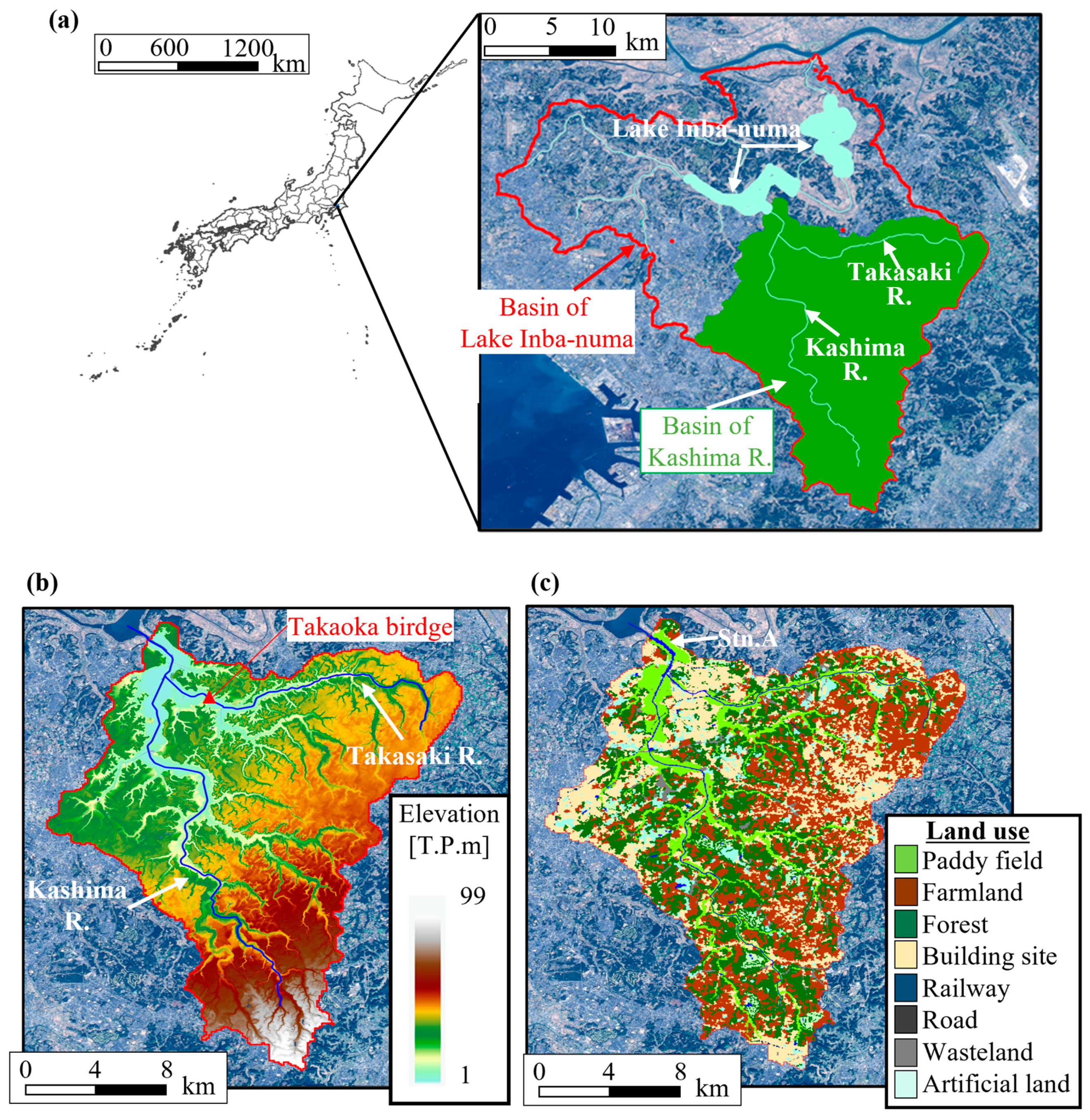



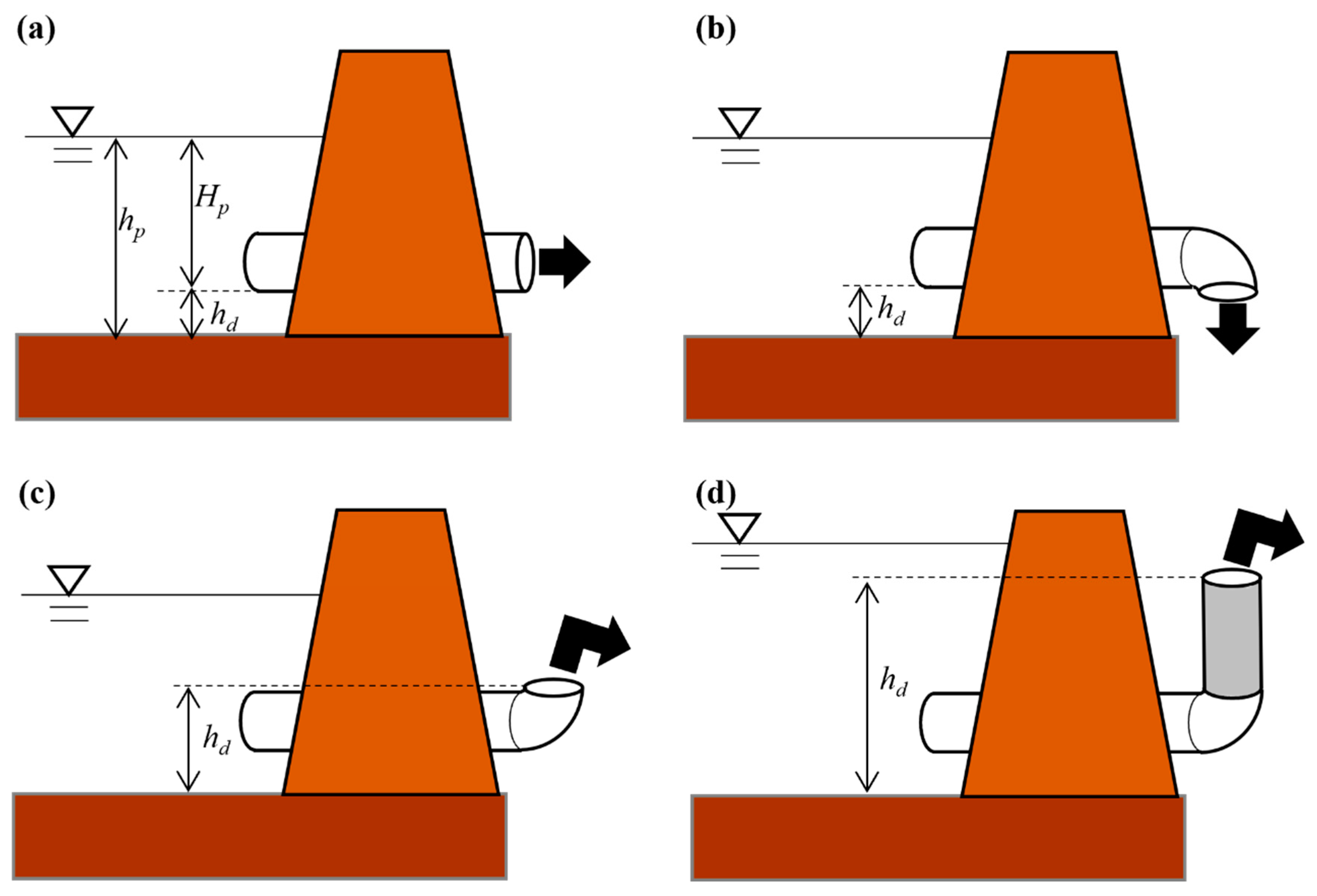


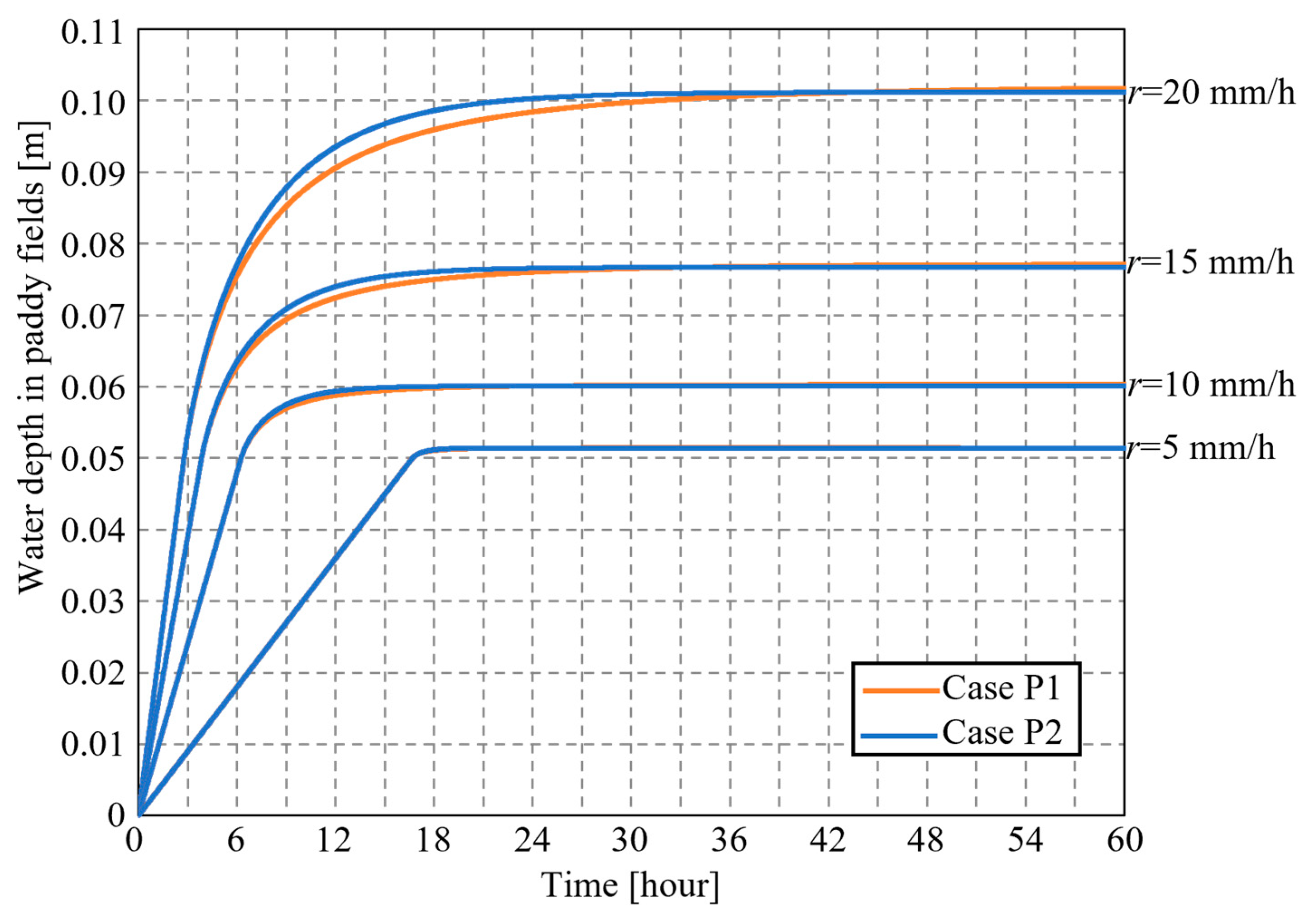


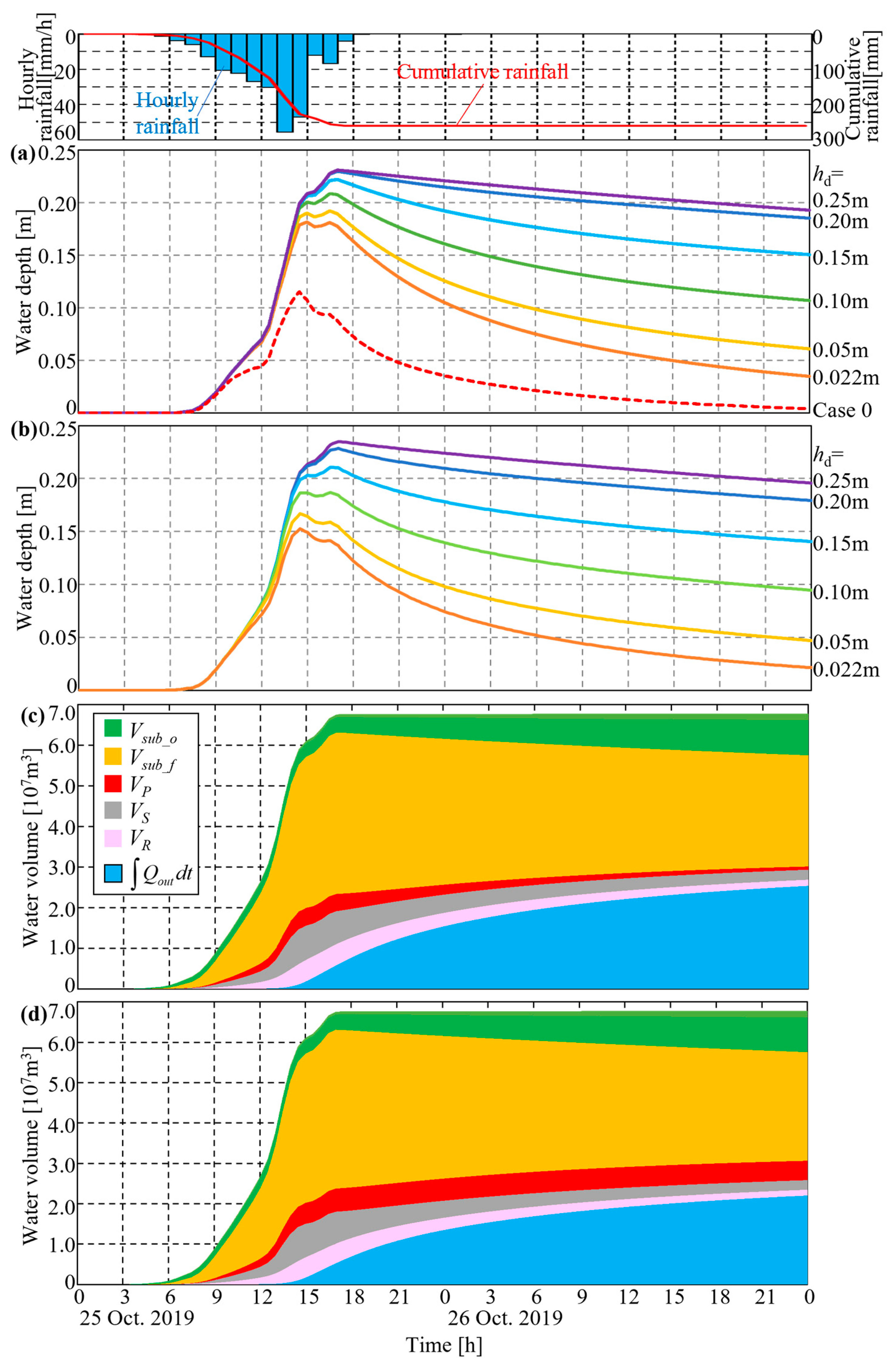

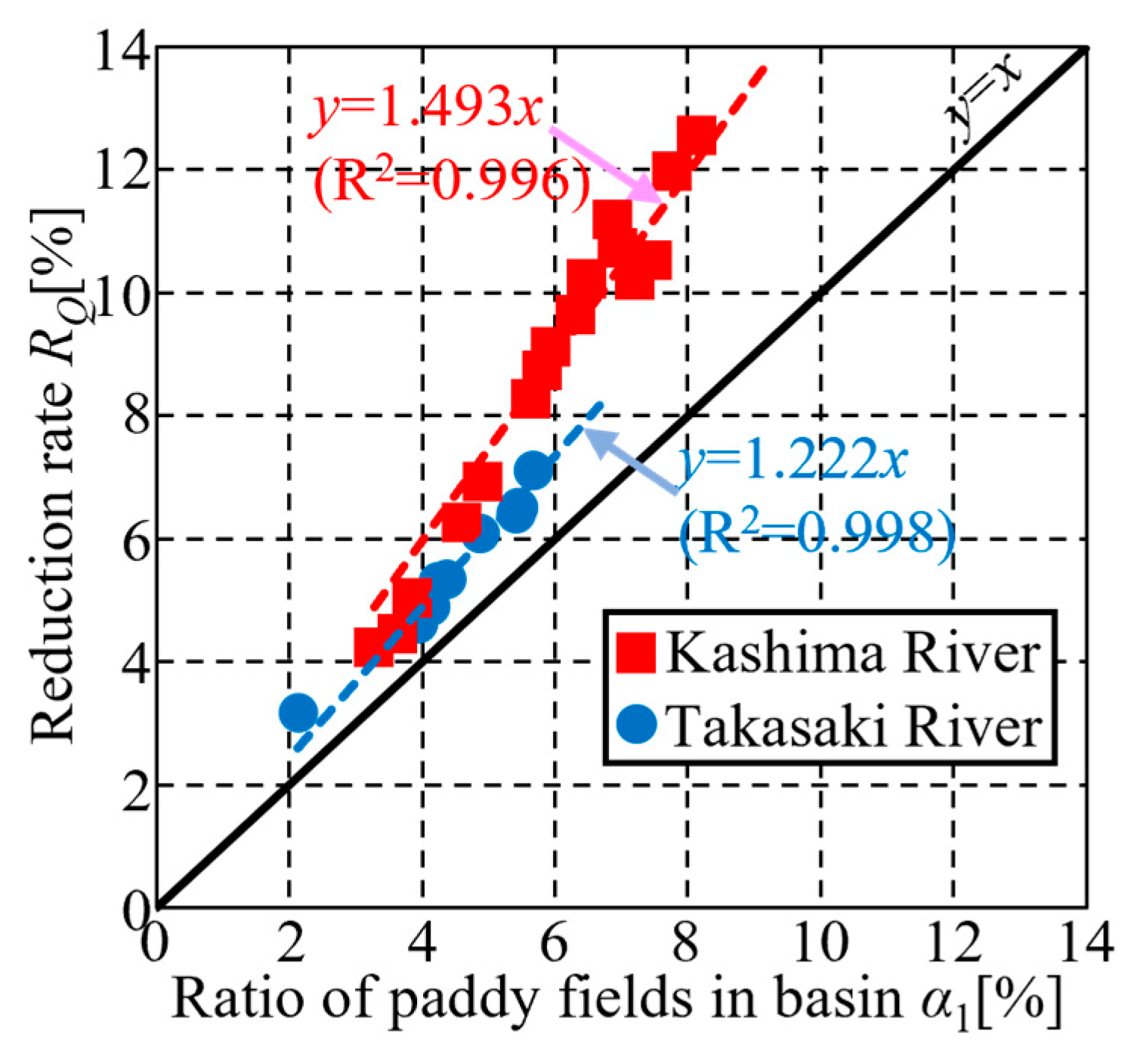
| Variables | Unit | Value |
|---|---|---|
| C | 0.65 | |
| a for qout | m2 | 7.85 × 10−3 |
| a for q′in (q′out) | m2 | 1.963 × 10−4 |
| hd | m | 0.05 |
| f | m/s | 5.67 × 10−7 |
| Case | Condition | Height of Free-Drain Pipe hd [m] |
|---|---|---|
| 0 | No paddy field model | |
| 1 | Current situation | 0.022 |
| 2 | Paddy field dam | 0.05, 0.10, 0.15, 0.20, 0.25 |
| Variables | Unit | Paddy Field | Farmland | Forest | Urban Area |
|---|---|---|---|---|---|
| Roughness coefficient n | m−1/3s | 1.00 | 0.40 | 0.40 | 0.20 |
| Soil depth Sd | m | 1.00 | 1.00 | 2.00 | 1.00 |
| Vertical infiltration coefficient kv | m/s | 1.51 × 10−7 | 2.40 × 10−7 | 0 | |
| Lateral infiltration coefficient ka | m/s | 0.15 | |||
| Porosity of saturated layer γa | 0.20 | 0.20 | 0.50 | 0.20 | |
| Porosity of unsaturated layer γm | 0.05 | ||||
| Suction Sf | m | 0.3163 | 0.239 | 0 | 0 |
Disclaimer/Publisher’s Note: The statements, opinions and data contained in all publications are solely those of the individual author(s) and contributor(s) and not of MDPI and/or the editor(s). MDPI and/or the editor(s) disclaim responsibility for any injury to people or property resulting from any ideas, methods, instructions or products referred to in the content. |
© 2024 by the authors. Licensee MDPI, Basel, Switzerland. This article is an open access article distributed under the terms and conditions of the Creative Commons Attribution (CC BY) license (https://creativecommons.org/licenses/by/4.0/).
Share and Cite
Nihei, Y.; Ogata, Y.; Yoshimura, R.; Ito, T.; Kashiwada, J. Subgrid Model of Water Storage in Paddy Fields for a Grid-Based Distributed Rainfall–Runoff Model and Assessment of Paddy Field Dam Effects on Flood Control. Water 2024, 16, 255. https://doi.org/10.3390/w16020255
Nihei Y, Ogata Y, Yoshimura R, Ito T, Kashiwada J. Subgrid Model of Water Storage in Paddy Fields for a Grid-Based Distributed Rainfall–Runoff Model and Assessment of Paddy Field Dam Effects on Flood Control. Water. 2024; 16(2):255. https://doi.org/10.3390/w16020255
Chicago/Turabian StyleNihei, Yasuo, Yuki Ogata, Ryosuke Yoshimura, Takehiko Ito, and Jin Kashiwada. 2024. "Subgrid Model of Water Storage in Paddy Fields for a Grid-Based Distributed Rainfall–Runoff Model and Assessment of Paddy Field Dam Effects on Flood Control" Water 16, no. 2: 255. https://doi.org/10.3390/w16020255
APA StyleNihei, Y., Ogata, Y., Yoshimura, R., Ito, T., & Kashiwada, J. (2024). Subgrid Model of Water Storage in Paddy Fields for a Grid-Based Distributed Rainfall–Runoff Model and Assessment of Paddy Field Dam Effects on Flood Control. Water, 16(2), 255. https://doi.org/10.3390/w16020255






